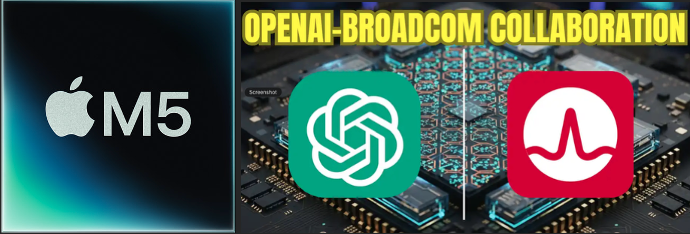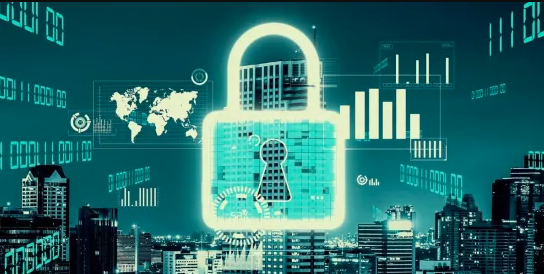Apple's M5 Chip & OpenAI's Massive Chip Deal: Tech News October 13-15, 2025

This week brought some of the most significant hardware announcements I've seen. Between Apple's next-generation silicon and OpenAI's ambitious push into custom chip development, it's clear that controlling your own hardware is now the name of the game in tech. Here's what caught my attention.
Apple Unleashes M5: A Quantum Leap for AI
Today, October 15th, Apple released a press release about what might be its most significant chip announcement since the M1 revolutionized the Mac. The M5 chip isn't just an incremental upgrade—it represents a fundamental shift in how Apple thinks about AI performance.
What makes this interesting is the architecture. Apple built Neural Accelerators directly into each GPU core, something I haven't seen before. This design delivers over 4x the peak GPU compute performance for AI compared to the M4, and over 6x compared to the M1. That's not evolutionary—that's a generational leap.
The specs tell an impressive story:
- 10-core GPU architecture with Neural Accelerators in each core
- Up to 10-core CPU (six efficiency cores, four performance cores)
- 15% faster multithreaded performance over M4
- 45% higher graphics performance with third-generation ray tracing
- 16-core Neural Engine with improved capabilities
- 153GB/s unified memory bandwidth (nearly 30% increase)
Built on third-generation 3-nanometer technology, the M5 launches first in the 14-inch MacBook Pro, iPad Pro, and Apple Vision Pro. How is Apple positioning this: Every compute block is optimized for AI? They're not just adding AI capabilities—they're rebuilding the entire chip architecture around it.
"M5 ushers in the next big leap in AI performance for Apple silicon," said Johny Srouji, Apple's senior vice president of Hardware Technologies. "With the introduction of Neural Accelerators in the GPU, M5 delivers a huge boost to AI workloads."
This matters because it shows Apple isn't content to let others lead in AI hardware. While competitors scramble for Nvidia GPUs, Apple is building its own path with silicon purpose-built for its ecosystem. The fact that they're launching this across MacBook, iPad, and Vision Pro simultaneously suggests they see AI as the unifying thread across all its products.
OpenAI Goes All-In on Custom Silicon with Broadcom
While Apple made headlines with M5, OpenAI dropped an even bigger bombshell on Monday, October 13th: a multi-year partnership with Broadcom to co-develop 10 gigawatts of custom AI accelerators. Let me put that number in perspective: OpenAI operates on just over 2 gigawatts. They're planning to increase their computing capacity fivefold.
This isn't just about buying more chips. OpenAI is designing the chips themselves, with Broadcom handling development and deployment. The first racks will start rolling out in late 2026 and continue through 2029.
Sam Altman explained the strategy in a podcast released with the announcement: "We can think from etching the transistors all the way up to the token that comes out when you ask ChatGPT a question, and design the whole system. We can get huge efficiency gains, leading to much better performance, faster models, cheaper models—all of that."
What's fascinating is how OpenAI is using its own AI models to design these chips. Greg Brockman, OpenAI's co-founder and president, revealed they've achieved "massive area reductions" by letting their models optimize components humans had already optimized. "You take components that humans have already optimized and just pour compute into it, and the model comes out with its own optimizations," he explained.
The market certainly took notice. Broadcom's stock soared nearly 10% on the news, adding over $150 billion to its market cap and pushing it past $1.5 trillion in valuation.
But here's what caught my attention: this Broadcom deal is just one piece of a much larger puzzle. Over the past three weeks, OpenAI has announced roughly 33 gigawatts of compute commitments across Nvidia, Oracle, AMD, and Broadcom partnerships. That's an absolutely staggering amount of infrastructure.
Google Bets Big on India
Not to be outdone, Google announced on October 14th that it will invest $15 billion over five years to build an AI hub in Visakhapatnam, India. This isn't just a data center—it's a comprehensive AI infrastructure combining data centers, large-scale energy sources, and an expanded fiber-optic network.
The timing makes sense. India is projected to have over 900 million internet users by year's end, and demand for AI tools and solutions is surging. By establishing this hub, Google is positioning itself to capture that growth while building local infrastructure that keeps data close to users.
What I find strategic about this move is how it mirrors what we're seeing across the industry: compute needs to be physically near talent, market demand, and regulatory context. You can't just centralize everything in U.S. data centers anymore.
The Vertical Integration Race
Looking at these three announcements together, I see a clear pattern emerging: vertical integration is back and happening at an unprecedented scale.
Apple has always controlled its hardware and software stack, but the M5 shows they're doubling down on that approach for AI. OpenAI, starting as a pure software/model company, is now designing custom silicon and building massive infrastructure. Google is expanding its physical infrastructure globally to support its AI ambitions.
This matters because it fundamentally changes the competitive landscape. Companies that control their entire stack—from silicon to software—can optimize in ways that companies relying on off-the-shelf components can't match.
Consider what OpenAI is doing: designing chips specifically for inference (generating responses) can dramatically reduce costs and improve performance. Industry estimates suggest a 1-gigawatt data center costs around $50 billion, with $35 billion typically going to chips alone. Custom silicon could slash those costs significantly.
But there's a flip side to this story. OpenAI's aggressive expansion raises serious questions about sustainability. Despite impressive growth, the company isn't profitable, and it's committing tens of billions to infrastructure. Many of these partnerships involve circular financing arrangements, where companies invest in OpenAI while simultaneously supplying it with technology. How long can that last?
What This Means for the Industry
We're witnessing a fundamental restructuring of the tech industry around AI infrastructure. Here's what I'm watching:
The End of Chip Monopolies: Nvidia has dominated AI compute for years. These custom chip initiatives from Apple, OpenAI, and others suggest that dominance may be eroding. When every major player designs their own silicon, the industry becomes more diverse and competitive.
Infrastructure as Competitive Moat: The companies winning in AI will not just be those with the best models or algorithms. They'll be the ones who can afford to build and operate massive compute infrastructure, which requires deep pockets and long-term vision.
Geographic Distribution: Google's India investment signals that AI infrastructure can't all be centralized. Latency, data sovereignty, and local market access matter. Expect more regional AI hubs globally.
Energy Becomes Critical: All this computing needs power—massive amounts of it. The data center industry is already grappling with energy constraints. As AI infrastructure scales, energy availability will increasingly limit growth.
My Takeaways
- Custom silicon is the new battleground: Companies that can design their own chips have a fundamental advantage in the AI era.
- Scale requires unprecedented capital: OpenAI's 33-gigawatt commitment shows how expensive the AI race has become. This favors deep-pocketed players.
- Apple is serious about AI. The M5 architecture shows that Apple isn't just adding AI features—it's rebuilding its entire platform around AI capabilities.
- India is becoming an AI powerhouse: Google's $15 billion investment validates India's importance as both a market and a talent hub.
- The infrastructure bubble question: All this infrastructure investment needs to generate returns at some point. I'm curious whether demand will keep pace with supply.
What's your take on this vertical integration trend? Do you think custom chips are the future, or will we see a return to standardized components? I'm curious to hear different perspectives.
Reference Sources:
Apple M5 Chip Announcement:
1. Apple Newsroom - "Apple unleashes M5, the next big leap in AI performance for Apple silicon" (October 15, 2025)
Source: https://www.apple.com/newsroom/2025/10/apple-unleashes-m5-the-next-big-leap-in-ai-performance-for-apple-silicon/ Apple unleashes M5, the next big leap in AI performance for Apple silicon - Apple
2. Geeky Gadgets - "Apple October 2025 Event: 7 New Products and Features Coming" (October 13, 2025)
Source: https://www.geeky-gadgets.com/apple-october-2025-event-rumors/ Apple October 2025 Event: 7 New Products and Features Coming - Geeky Gadgets
OpenAI & Broadcom Partnership:
3. OpenAI Official - "OpenAI and Broadcom announce strategic collaboration to deploy 10 gigawatts of OpenAI-designed AI accelerators" (October 13, 2025)
Source: https://openai.com/index/openai-and-broadcom-announce-strategic-collaboration/ BroadcomOpenAI
4. CNBC - "Broadcom stock pops 9% on OpenAI custom chip deal" (October 13, 2025)
Source: https://www.cnbc.com/2025/10/13/openai-partners-with-broadcom-custom-ai-chips-alongside-nvidia-amd.html Broadcom stock pops 9% on OpenAI custom chip deal, adding to Nvidia and AMD agreements
5. CNBC - "OpenAI's latest deals show an aggressive pivot to control every part of its business" (October 14, 2025)
Source: https://www.cnbc.com/2025/10/14/open-ai-hyperscaler-broadcom-chips.html OpenAI's latest deals show an aggressive pivot to control every part of its business
6. AI Dispatch - "Daily Trends and Innovations – October 14, 2025" (October 14, 2025)
7. Source: https://hipther.com/latest-news/2025/10/14/ai-dispatch-daily-trends-and-innovations-october-14-2025 AI Dispatch: Daily Trends and Innovations – October 14, 2025 (OpenAI & Broadcom, Oracle & AMD, NVIDIA DGX Spark, Google AI Hub, Cerebras)
Google India Investment:
7. Caixin Global - "Tech Brief (Oct. 15): Google to Invest $15 Billion in India for AI Hub" (October 14, 2025)
Source: https://www.caixinglobal.com/2025-10-15/tech-brief-oct-15-google-to-invest-15-billion-in-india-for-ai-hub Tech Brief (Oct. 15): Google to Invest $15 Billion in India for AI Hub - Caixin Global
8. CNBC Technology - "Google to invest $15 billion to build AI hub in India" (October 14, 2025)


